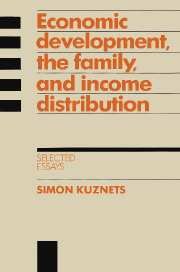Book contents
- Frontmatter
- Contents
- Preface by Louis Galambos and Robert Gallman
- Foreword by Richard A. Easterlin
- 1 Driving forces of economic growth: what can we learn from history?
- 2 A note on production structure and aggregate growth
- 3 The pattern of shift of labor force from agriculture, 1950–70
- 4 Modern economic growth and the less developed countries
- 5 Notes on demographic change
- 6 Recent population trends in less developed countries and implications for internal income inequality
- 7 Demographic aspects of the size distribution of income: an exploratory essay
- 8 Size and age structure of family households: exploratory comparisons
- 9 Size of households and income disparities
- 10 Distributions of households by size: differences and trends
- 11 Children and adults in the income distribution
- Afterword: Some notes on the scientific methods of Simon Kuznets by Robert William Fogel
- Bibliography of Simon Kuznets
- Index
6 - Recent population trends in less developed countries and implications for internal income inequality
Published online by Cambridge University Press: 12 November 2009
- Frontmatter
- Contents
- Preface by Louis Galambos and Robert Gallman
- Foreword by Richard A. Easterlin
- 1 Driving forces of economic growth: what can we learn from history?
- 2 A note on production structure and aggregate growth
- 3 The pattern of shift of labor force from agriculture, 1950–70
- 4 Modern economic growth and the less developed countries
- 5 Notes on demographic change
- 6 Recent population trends in less developed countries and implications for internal income inequality
- 7 Demographic aspects of the size distribution of income: an exploratory essay
- 8 Size and age structure of family households: exploratory comparisons
- 9 Size of households and income disparities
- 10 Distributions of households by size: differences and trends
- 11 Children and adults in the income distribution
- Afterword: Some notes on the scientific methods of Simon Kuznets by Robert William Fogel
- Bibliography of Simon Kuznets
- Index
Summary
In a recent paper (chapter 7, below) I explored the effects on the conventional measures of distribution of income among households of demographic elements such as the size and changing composition of house holds through their life cycle. The exploration emphasized the need to take explicit account of these demographic elements in any attempt to observe trends in the long-term levels of income differentials – particularly those associated with economic growth, since the latter is usually accompanied by marked shifts in the size and age-of-head distributions of households. Of particular interest was the negative association between per capita income and size of the household or family, found also within the age-of-head classes and thus persisting through the household's lifespan. If this cross-sectional association is translated into comparisons of per capita income for households of differing average size over the lifespan, the result is a negative association between the per capita income and size variables. Since, in turn, size of households or families is largely a function of the number of children, the negative association just noted is also one between lifetime per capita income and fertility – provided that the differentials in fertility dominate differentials in mortality, as they did in the small sample of countries for recent years used in the cross section in my recent paper.
- Type
- Chapter
- Information
- Economic Development, the Family, and Income DistributionSelected Essays, pp. 87 - 130Publisher: Cambridge University PressPrint publication year: 1989



